Sharphooks
Well-Known Member
I ended up missing my ferry back to Rupert.
According to the ticket it would depart at “12:30 AM”.
But wouldn’t a ferry line use military time? Wouldn’t the ticket have indicated “00:30”? Yes, my ferry was departing just a few clicks after 12:00 o’clock noon. No doubt. No, wait a minute....if it left in the afternoon wouldn’t the ticket have had a PM printed on it instead of an AM?
I played these silly head games while out in the bush. I didn’t have internet so I couldn’t place a call or get online to confirm the true sailing timing. Yes, it was all a bit reckless. BC Ferries had switched to their winter schedule and there were only a few sailings back to Rupert each week and whatever sailings there were had been booked solid. No rezz? Forget about it, especially with an oversized camper.
The truth was I just didn’t want to leave Haida Gwaii. I’ve never formed an attachment with a place so quick. Never. If that group of islands was a woman I’d handcuff myself to her ankles and consider blowing my head off if she ever left me.
Once I confirmed I’d missed my ferry (and my non-refundable ticket due to “no show”) I felt like a free man again. I rubbed my flippers together with glee—-I could now go to Rose Spit!
I drove to Masset then out towards North Beach on the Naikoon Peninsula. Tow Hill (pronounced to rhyme with “cow”) is a huge basalt upheaval left by retreating glaciers and burnished by winter storms.
The gargantuan palisade is also a conveniently placed landmark that Haida warriors used as a homing beacon in the fog when they came back across Dixon Entrance after slaughtering Tlingits and taking Tlingit slaves off the Alaskan coast. And if any Tlingits were foolhardy enough to chase the warring parties back to Haida Gwaii, the Haidas would scramble up to the top of Tow Hill and flatten the Tlingits below with rocks and tree logs heaved down from the peak of their impregnable redoubt.
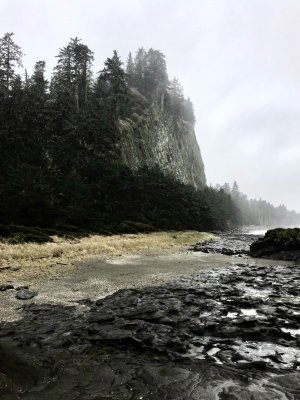
The basalt formations at its base are not what you expect to see after seeing all those endless sandy white beaches on the rest of the Northern part of Graham Island.
If I was a Tlingit trying to get payback on a pugnacious group of Haidas who’d just bashed in my brother’s head in with a rock tied to strip of twisted cedar bark back on Prince of Whales Island, not sure I’d want to risk my canoe landing on this:
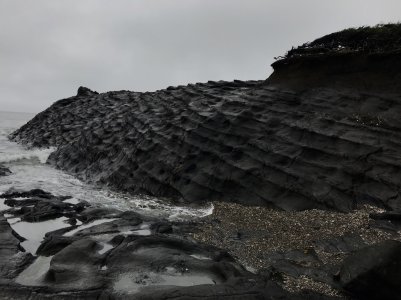
The climb to the top of Tow Hill is a bit arduous but well worth the view—— you get a peep at most of North Beach and Rose Spit off in the distance. You also see the Alaskan coast——when you consider rowing there across Dixon Entrance in a cedar canoe you develop a huge respect for the Haida warriors that routinely made that crossing. They also paddled across Hecate Strait ROUTINELY in their canoes, going as far south as Victoria and as far north as Sitka.
Looking off across North Beach towards Rose Spit from the top of Tow Hill:
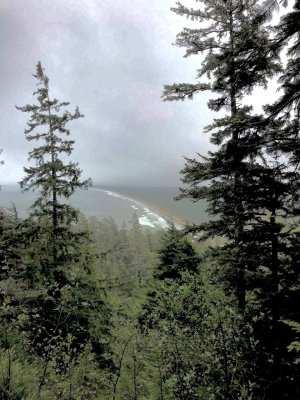
At the base of Tow Hill a breadbasket of a river flows into Hecate Strait. At the mouth of the Heillen River are huge sand flats loaded with razor clams. Despite the tannins in the river water, the coho thrive. I saw wads of them coming across the flat on an incoming tide.
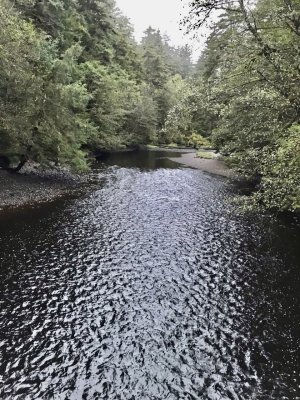
I would have loved to do the hike out to Rose Spit but it’s a 25 km round trip from Tow Hill and you’re dealing with tides that would push you up into the trees. And there are also lots of these prowling the beaches:
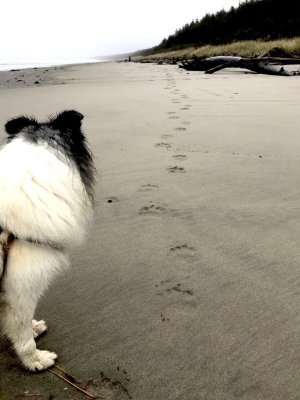
Instead, the dog and I did a 25 km hike across the spine of Rose Spit from the mouth of the Heillen River to Cape Fife. That hike gives you a good sense of the different habitat moods of Haida Gwaii as you move from sandy beach into thick forest which transitions to tundra and bogs (known as the Argonaut Plain) then back to the sandy white beaches of Hecate Strait at Cape Fife:
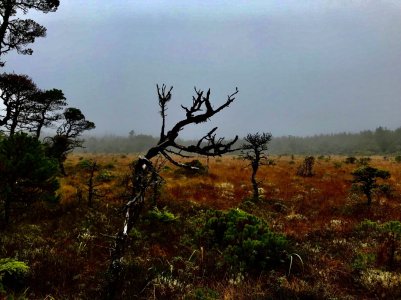
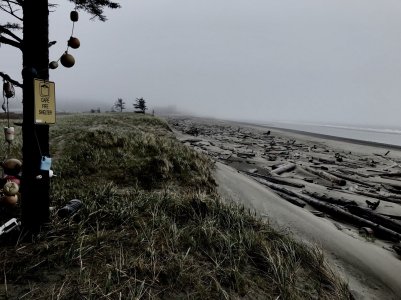
Once we arrived at Cape Fife, we were blasted by wind coming in off Hecate Strait. It was not a friendly place. It wasn’t raining but the mist was so thick it might have been pouring. And the dog started its throaty growling which meant there were bears in the bushes and we beat a retreat back to Tow Hill.
It was poignant once I finally boarded the ferry and saw Haida Gwaii receding off in the distance. It had been truly a magical experience for me. I finally as of this writing have a boat that I would be comfortable crossing Hecate Strait in during the summer months but somehow I don’t think I’ll ever make the trip.
Part of it is I don’t want to be just another resource extracting white guy beating up on Haida fish when I get there. I know that sounds goofy and maybe a bit disingenuous but that was the residual sentiment I was left with after reading about the history of that part of the world and what the long line of resource extractors did to the Haida culture and the Haida food supplies (whales, salmon, razor clams etc, all commercially exploited until depletion rendered the operations no longer commercially feasible) during the 18th and 19th centuries. It ain’t a pretty story.
My favorite anecdote of what white traders wrought on the Haida? A trader in Victoria severed the hand off a cadaver that had died of smallpox then sealed it up in a barrel of molasses he’d sold to a group of Haidas heading back to their islands.
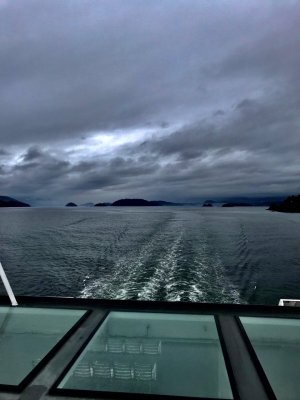
The upside of my ferry crossing was it was a day crossing and I got to see what Hecate Strait can look like when a 25 —- 35 knt southerly hits an ebb tide.
The Northern Expedition is a relatively new addition to the BC Ferry fleet—-built in Germany in 2008, it has stabilizers welded onto the hull to minimize rolling. But if you stood up out of your seat on this crossing you would have keeled over. Barf bags were being handed out in six-packs —-no surprise to see the thick chains that are used to secure trucks and trailers in place down on the car decks.
The crossing back to Rupert ended up being a 6 hours steam in the trough (!!) of 3 to 4 meter waves..... for the entire trip! I heard from a deck guy that management almost pulled the plug on that sailing due to those sea conditions
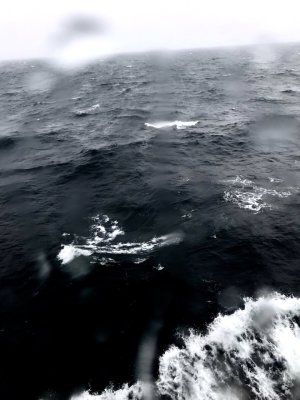
When we arrived in Rupert it was pouring rain, the first real rainfall I’d seen on a three week trip. It made me realize how incredibly lucky I’d been on my Haida Gwaii expedition: mostly blue skies!
So, faced with a really long drive back home I decided to break up the drive by spending a few more days on Mother Skeena. And just to baptize the end of an incredible trip, I barbecued one of the coho I caught on Haida Gwaii over a beach fire on her bank.
It was quite a chore finding enough driftwood to make that last rip-roarer of a fire....ha ha .....
While driving through Burns Lake at the start of this trip heading north, I bought a grill that made the whole Skeena/Haida Gwaii expedition a resounding success: the grill set-up pins the fillet in a tight spot so it can’t shift and if you shield it from active flames during the cooking process, you can end up with a gloriously cooked full fillet without one ounce of meat being burned or over-cooked....highly recommend that grill to anyone doing beach party bingo with a fire and a fish!
So....as the sun set that last night on the Skeena, it was also setting on a remarkable trip for me. And for the first time in my life I regretted having fewer Octobers remaining ahead of me as Octobers behind me. But I knew I just had to go back to Haida Gwaii....Moresby Island is another treasure trove of Haida culture, but more difficult to access by road. Somehow I would try to get there.
And I realized now I have another golden carrot to hang out in front of me.
I don’t know much but I have learned that the secret charm of staying younger then your years is to remain perpetually prepared for the next exhilarating process of discovery.
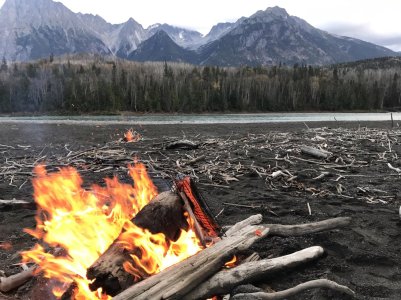
According to the ticket it would depart at “12:30 AM”.
But wouldn’t a ferry line use military time? Wouldn’t the ticket have indicated “00:30”? Yes, my ferry was departing just a few clicks after 12:00 o’clock noon. No doubt. No, wait a minute....if it left in the afternoon wouldn’t the ticket have had a PM printed on it instead of an AM?
I played these silly head games while out in the bush. I didn’t have internet so I couldn’t place a call or get online to confirm the true sailing timing. Yes, it was all a bit reckless. BC Ferries had switched to their winter schedule and there were only a few sailings back to Rupert each week and whatever sailings there were had been booked solid. No rezz? Forget about it, especially with an oversized camper.
The truth was I just didn’t want to leave Haida Gwaii. I’ve never formed an attachment with a place so quick. Never. If that group of islands was a woman I’d handcuff myself to her ankles and consider blowing my head off if she ever left me.
Once I confirmed I’d missed my ferry (and my non-refundable ticket due to “no show”) I felt like a free man again. I rubbed my flippers together with glee—-I could now go to Rose Spit!
I drove to Masset then out towards North Beach on the Naikoon Peninsula. Tow Hill (pronounced to rhyme with “cow”) is a huge basalt upheaval left by retreating glaciers and burnished by winter storms.
The gargantuan palisade is also a conveniently placed landmark that Haida warriors used as a homing beacon in the fog when they came back across Dixon Entrance after slaughtering Tlingits and taking Tlingit slaves off the Alaskan coast. And if any Tlingits were foolhardy enough to chase the warring parties back to Haida Gwaii, the Haidas would scramble up to the top of Tow Hill and flatten the Tlingits below with rocks and tree logs heaved down from the peak of their impregnable redoubt.

The basalt formations at its base are not what you expect to see after seeing all those endless sandy white beaches on the rest of the Northern part of Graham Island.
If I was a Tlingit trying to get payback on a pugnacious group of Haidas who’d just bashed in my brother’s head in with a rock tied to strip of twisted cedar bark back on Prince of Whales Island, not sure I’d want to risk my canoe landing on this:

The climb to the top of Tow Hill is a bit arduous but well worth the view—— you get a peep at most of North Beach and Rose Spit off in the distance. You also see the Alaskan coast——when you consider rowing there across Dixon Entrance in a cedar canoe you develop a huge respect for the Haida warriors that routinely made that crossing. They also paddled across Hecate Strait ROUTINELY in their canoes, going as far south as Victoria and as far north as Sitka.
Looking off across North Beach towards Rose Spit from the top of Tow Hill:

At the base of Tow Hill a breadbasket of a river flows into Hecate Strait. At the mouth of the Heillen River are huge sand flats loaded with razor clams. Despite the tannins in the river water, the coho thrive. I saw wads of them coming across the flat on an incoming tide.

I would have loved to do the hike out to Rose Spit but it’s a 25 km round trip from Tow Hill and you’re dealing with tides that would push you up into the trees. And there are also lots of these prowling the beaches:

Instead, the dog and I did a 25 km hike across the spine of Rose Spit from the mouth of the Heillen River to Cape Fife. That hike gives you a good sense of the different habitat moods of Haida Gwaii as you move from sandy beach into thick forest which transitions to tundra and bogs (known as the Argonaut Plain) then back to the sandy white beaches of Hecate Strait at Cape Fife:


Once we arrived at Cape Fife, we were blasted by wind coming in off Hecate Strait. It was not a friendly place. It wasn’t raining but the mist was so thick it might have been pouring. And the dog started its throaty growling which meant there were bears in the bushes and we beat a retreat back to Tow Hill.
It was poignant once I finally boarded the ferry and saw Haida Gwaii receding off in the distance. It had been truly a magical experience for me. I finally as of this writing have a boat that I would be comfortable crossing Hecate Strait in during the summer months but somehow I don’t think I’ll ever make the trip.
Part of it is I don’t want to be just another resource extracting white guy beating up on Haida fish when I get there. I know that sounds goofy and maybe a bit disingenuous but that was the residual sentiment I was left with after reading about the history of that part of the world and what the long line of resource extractors did to the Haida culture and the Haida food supplies (whales, salmon, razor clams etc, all commercially exploited until depletion rendered the operations no longer commercially feasible) during the 18th and 19th centuries. It ain’t a pretty story.
My favorite anecdote of what white traders wrought on the Haida? A trader in Victoria severed the hand off a cadaver that had died of smallpox then sealed it up in a barrel of molasses he’d sold to a group of Haidas heading back to their islands.

The upside of my ferry crossing was it was a day crossing and I got to see what Hecate Strait can look like when a 25 —- 35 knt southerly hits an ebb tide.
The Northern Expedition is a relatively new addition to the BC Ferry fleet—-built in Germany in 2008, it has stabilizers welded onto the hull to minimize rolling. But if you stood up out of your seat on this crossing you would have keeled over. Barf bags were being handed out in six-packs —-no surprise to see the thick chains that are used to secure trucks and trailers in place down on the car decks.
The crossing back to Rupert ended up being a 6 hours steam in the trough (!!) of 3 to 4 meter waves..... for the entire trip! I heard from a deck guy that management almost pulled the plug on that sailing due to those sea conditions

When we arrived in Rupert it was pouring rain, the first real rainfall I’d seen on a three week trip. It made me realize how incredibly lucky I’d been on my Haida Gwaii expedition: mostly blue skies!
So, faced with a really long drive back home I decided to break up the drive by spending a few more days on Mother Skeena. And just to baptize the end of an incredible trip, I barbecued one of the coho I caught on Haida Gwaii over a beach fire on her bank.
It was quite a chore finding enough driftwood to make that last rip-roarer of a fire....ha ha .....
While driving through Burns Lake at the start of this trip heading north, I bought a grill that made the whole Skeena/Haida Gwaii expedition a resounding success: the grill set-up pins the fillet in a tight spot so it can’t shift and if you shield it from active flames during the cooking process, you can end up with a gloriously cooked full fillet without one ounce of meat being burned or over-cooked....highly recommend that grill to anyone doing beach party bingo with a fire and a fish!
So....as the sun set that last night on the Skeena, it was also setting on a remarkable trip for me. And for the first time in my life I regretted having fewer Octobers remaining ahead of me as Octobers behind me. But I knew I just had to go back to Haida Gwaii....Moresby Island is another treasure trove of Haida culture, but more difficult to access by road. Somehow I would try to get there.
And I realized now I have another golden carrot to hang out in front of me.
I don’t know much but I have learned that the secret charm of staying younger then your years is to remain perpetually prepared for the next exhilarating process of discovery.

Last edited:
